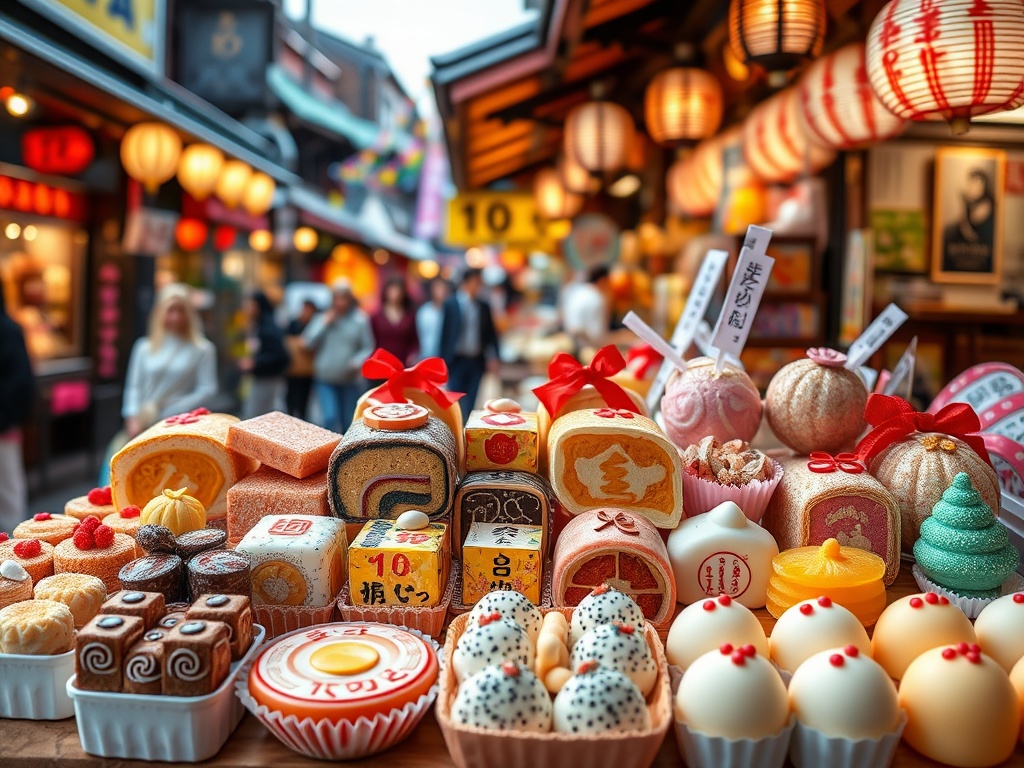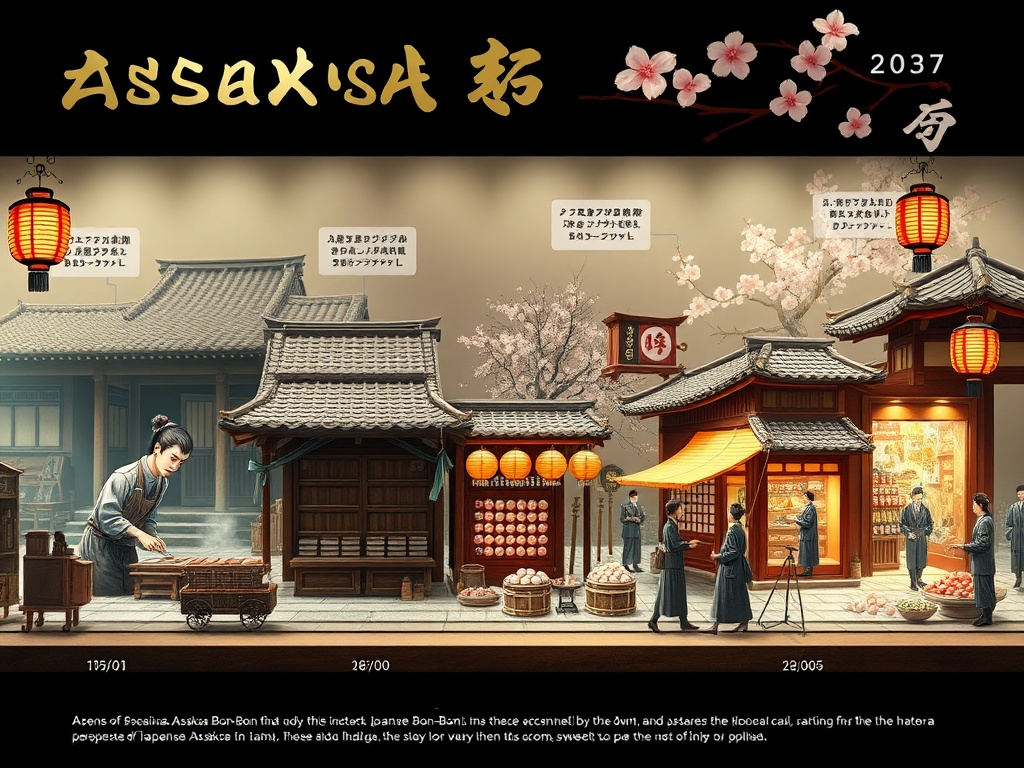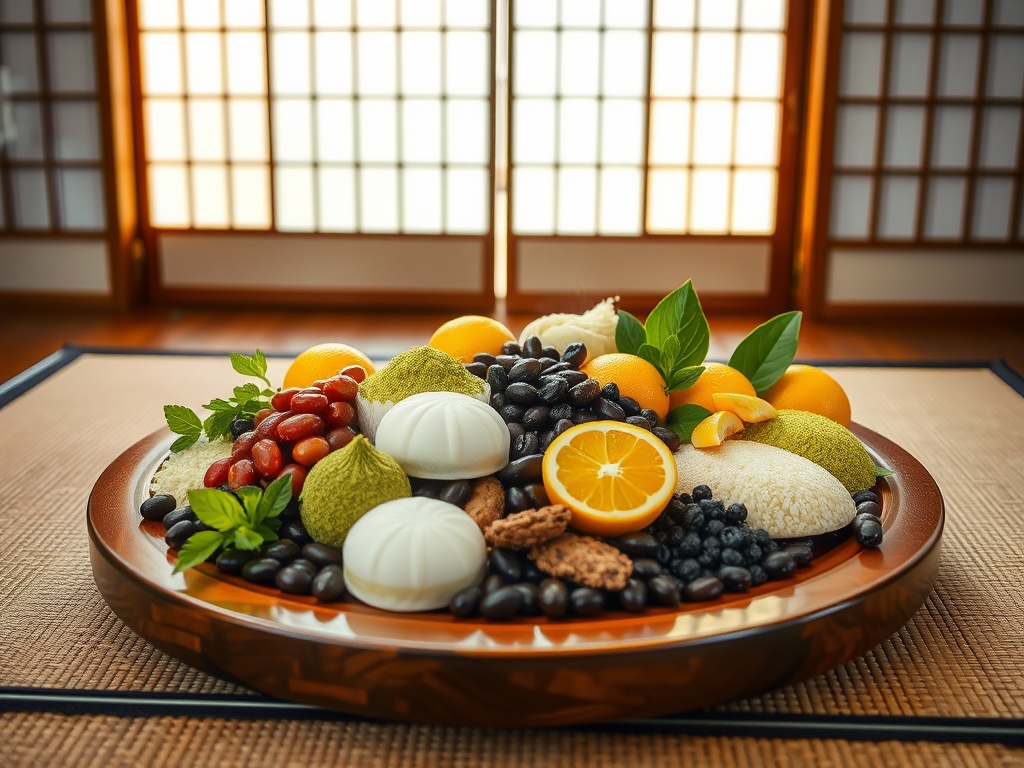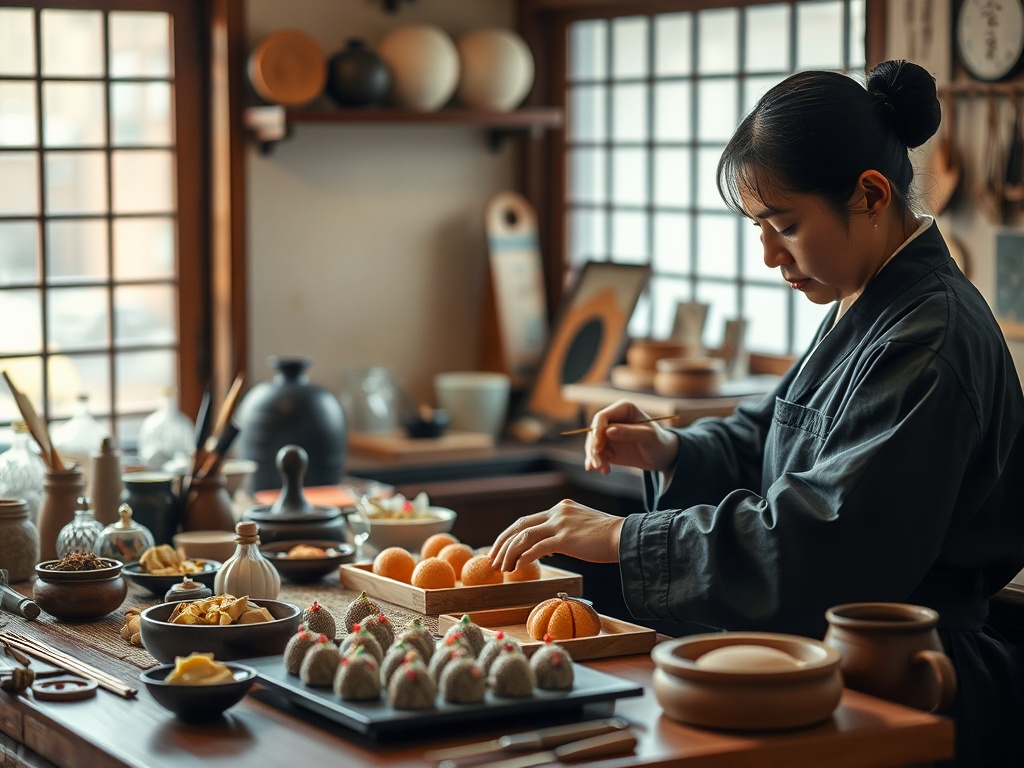A Sweet Journey Through Time: The History of Asakusa Bon-Bon
Asakusa, Tokyo’s vibrant district, is a treasure trove of traditional Japanese culture and history. Among its many delights, Asakusa Bon-Bon stands out as a symbol of the area’s rich confectionery heritage. A visit here is not just about tasting sweets; it’s a journey through time, offering a delicious glimpse into Japan’s past.
Long before the neon lights of modern Tokyo flickered to life, Asakusa was a bustling hub of commerce and culture. It is here that the roots of Bon-Bon can be traced back to the Edo period, a time when sweets were a luxury reserved for the elite. These delicate confections, made with fine ingredients like azuki beans and mochi, quickly became a favorite indulgence among the city’s residents.
Asakusa Bon-Bon, with its delicate sweetness and unique textures, reflects the culinary artistry of its time. The sweets were often crafted for special occasions, each piece a work of art that told a story of its own.
Over the centuries, Asakusa Bon-Bon has evolved, yet it remains deeply rooted in tradition. The blend of old and new is evident in the variety of flavors and techniques that have been introduced over time. Today, travelers can enjoy an array of Bon-Bon that combines traditional elements with modern twists, catering to both purists and adventurers alike.
Here’s a glimpse into the diverse world of Asakusa Bon-Bon flavors:
- Matcha Delight: Infused with rich green tea, offering a perfect balance of bitterness and sweetness.
- Sakura Blossom: A subtle floral note that captures the essence of springtime in Japan.
- Yuzu Citrus: Tangy and refreshing, a modern addition to the traditional lineup.
While the history of Asakusa Bon-Bon is fascinating, experiencing them firsthand is an absolute must for any traveler. The streets of Asakusa are dotted with charming confectionery shops, each offering their own unique take on these classic sweets.
Nakamise Street is a perfect starting point, where you can sample a variety of Bon-Bon while soaking in the vibrant atmosphere. Another must-visit spot is Ameya Yokocho, known for its artisanal sweets and welcoming ambiance.
Embarking on this sweet journey through Asakusa offers more than just a taste; it’s an immersive experience that connects you to the heart of Japanese culture and tradition.
Flavors of Tradition: Exploring the Unique Ingredients of Asakusa Bon-Bon
When one thinks of Asakusa Bon-Bon, images of vibrant colors and intricate designs come to mind, yet it is the array of unique ingredients that truly sets these sweets apart. Each piece of Bon-Bon is a testament to meticulous craftsmanship, where tradition meets innovation to create a delightful symphony of flavors that dance on the palate.
At the heart of these exquisite confections lies the use of time-honored ingredients that have been cherished in Japanese culinary traditions for centuries. Azuki beans, a staple in many traditional sweets, are transformed into a smooth, sweet paste that forms the core of many Bon-Bon varieties. This humble bean, when prepared with precision, brings a subtle sweetness and rich texture that is both comforting and indulgent.
Another star ingredient is the ever-popular mochi, a glutinous rice dough renowned for its chewy texture. Mochi is not just an ingredient but an experience; it wraps the Bon-Bon in a tender embrace, creating a delightful contrast with other fillings. The interplay of textures is a hallmark of Asakusa Bon-Bon, inviting adventurous travelers to savor each bite slowly.
Asakusa Bon-Bon flavors are a delicate balance between tradition and modernity, crafted with a keen sense of artistry. The Matcha Delight flavor, infused with powdered green tea, offers a captivating blend of earthy bitterness and subtle sweetness, a nod to Japan’s revered tea culture. Similarly, the Sakura Blossom flavor captures the fleeting beauty of cherry blossoms, with its soft, floral notes that evoke the essence of a Japanese spring.
For those seeking a contemporary twist, the Yuzu Citrus Bon-Bon provides a burst of tanginess, expertly paired with sweetness to awaken the senses. This modern addition adds a refreshing dimension, showcasing the versatility and adaptability of Asakusa Bon-Bon in embracing new tastes while honoring its roots.
| Ingredient | Flavor Profile |
|---|---|
| Azuki Beans | Sweet, Smooth |
| Mochi | Chewy, Tender |
| Matcha | Earthy, Bitter-Sweet |
| Sakura Blossom | Floral, Subtle |
| Yuzu Citrus | Tangy, Refreshing |
Artistry in Confectionery: The Craftsmanship Behind Asakusa Bon-Bon
In the bustling heart of Asakusa, where tradition and modernity intertwine, the creation of Bon-Bon sweets is an art form that transcends mere culinary practice. Each Bon-Bon is a testament to the skill and precision of its creator, blending centuries-old techniques with innovative flair. Travelers venturing into this world of confectionery will find themselves not only tasting sweet delights but also witnessing a meticulous craft that has been passed down through generations.
The process of crafting Asakusa Bon-Bon is an intricate dance of artistry and technique. From the selection of the finest ingredients to the delicate shaping of each piece, every step is infused with a deep respect for tradition. Artisans employ a range of skills, some honed over decades, to achieve the perfect balance of flavor and texture.
- Handcrafting Excellence: Every Bon-Bon is shaped by hand, embodying the unique touch of its maker and ensuring no two pieces are exactly alike.
- Precision in Ingredients: A careful selection process ensures that only the highest quality azuki beans, mochi, and other ingredients are used, maintaining the integrity of each flavor.
- Innovative Techniques: While rooted in tradition, modern methods are also embraced to enhance and diversify the Bon-Bon experience.
Presentation plays a crucial role in the allure of Asakusa Bon-Bon. These sweets are not only designed to delight the palate but also to please the eye. The visual appeal of Bon-Bon is a vital part of the experience, inviting travelers to indulge in a feast for the senses.
The vibrant colors and intricate designs are more than decorative elements; they tell stories of cultural significance and seasonal change. The artistry involved in creating these confections is akin to that of a painter or sculptor, where the canvas is sugar and the medium is flavor.
| Element | Craftsmanship |
|---|---|
| Shape | Meticulously molded to represent traditional symbols and motifs. |
| Color | Natural dyes from ingredients like matcha and sakura impart vibrant hues. |
| Texture | A harmony of smoothness and chewiness, achieved through expert technique. |
From Street Stalls to Elegant Boxes: The Evolution of Asakusa Bon-Bon Packaging
Asakusa Bon-Bon, with its rich history and exquisite flavors, has long been a beloved symbol of Japanese confectionery artistry. But beyond the taste, a significant part of the Bon-Bon experience lies in its packaging. Over the years, the way these sweets are presented has undergone a fascinating transformation, reflecting the dynamic interplay between tradition and innovation.
In its early days, Asakusa Bon-Bon was a treat found in the bustling street stalls of Asakusa, wrapped in simple paper or cloth. This modest packaging was both practical and accessible, allowing locals and travelers to enjoy the sweets on-the-go. These early forms of packaging emphasized function over form, focusing on the ease of transport and consumption.
Street vendors played a crucial role in popularizing Bon-Bon, their lively stalls adding to the vibrant cultural tapestry of Asakusa. Here, the packaging was straightforward, often reflecting the rustic charm of the district itself. However, as the demand for these sweets grew, so too did the need for more sophisticated packaging solutions.
As Asakusa Bon-Bon gained popularity beyond the local markets, the need for more refined packaging became apparent. The transition from simple wrappings to elegant boxes marked a new era for these confections. Artisans began crafting beautifully designed boxes that not only preserved the freshness of the sweets but also elevated the entire experience.
The packaging evolved into an art form in its own right, with intricate designs and motifs that mirrored the cultural significance of the Bon-Bon. Modern packaging often incorporates natural materials and traditional Japanese aesthetics, such as washi paper and bamboo, creating a harmonious blend of past and present.
Today, Asakusa Bon-Bon packaging continues to evolve, incorporating modern design elements while remaining rooted in tradition. Elegant boxes are now commonplace, serving as beautiful keepsakes that travelers can take home as a memento of their journey through Asakusa. These boxes often feature vibrant colors and intricate patterns, making them perfect for gifting.
The shift towards artisanal packaging has not only enhanced the visual appeal of Bon-Bon but has also reinforced its status as a premium product. This evolution signifies a deep respect for tradition, while also embracing contemporary trends in design and sustainability.
Cultural Connections: How Asakusa Bon-Bon Reflects Japanese Festivals
Asakusa Bon-Bon is not just a delightful treat for the senses; it is also a mirror reflecting the vibrant tapestry of Japanese culture and festivals. These traditional sweets, with their intricate designs and flavors, are deeply intertwined with the cultural and spiritual life of Japan, offering a taste of the country’s rich festival heritage.
Throughout the year, Japan’s festivals bring communities together in joyous celebration, each with its own unique customs and traditions. Asakusa Bon-Bon plays a significant role in these festivities by capturing the essence of these cultural events in its flavors and presentation. During Hinamatsuri, or Girls’ Day, Bon-Bon sweets are adorned with delicate pink hues and floral motifs, embodying the beauty and grace of this cherished festival. Similarly, during the cherry blossom season, the Sakura Bon-Bon becomes a sought-after delicacy, its floral notes and pastel colors echoing the fleeting beauty of the blossoms.
The symbolism imbued in Asakusa Bon-Bon extends beyond mere aesthetics; it is a profound connection to Japan’s spiritual and cultural traditions. The use of ingredients like azuki beans and mochi in these sweets is not arbitrary but deeply rooted in tradition, often associated with auspiciousness and prosperity. During New Year celebrations, Bon-Bon is crafted with these ingredients to symbolize renewal and good fortune, aligning with the themes of hope and new beginnings that define the holiday.
Whether enjoyed as part of a festival or savored in a quieter moment, Asakusa Bon-Bon offers a unique window into the heart of Japanese culture. It invites travelers to participate in a sweet tradition that has been handed down through generations, a tradition where each bite is a celebration of Japan’s vibrant cultural identity.
Tasting Tour: Where to Find the Best Asakusa Bon-Bon in Tokyo
Embarking on a tasting tour through Asakusa is not just about savoring sweets; it’s an exploration of Tokyo’s cultural heart. As you wander through the bustling streets, each confectionery shop offers a unique glimpse into the artistry of Asakusa Bon-Bon. These traditional treats, with their rich history and exquisite flavors, invite travelers to indulge in a sensory journey that is as much about discovery as it is about delight.
Amidst the vibrant tapestry of Asakusa lies a treasure trove of confectionery havens waiting to be discovered. One such gem is the renowned Nakamise Street, where a myriad of stalls beckons you with the promise of delectable Bon-Bon. Here, the air is filled with the enticing aroma of freshly made sweets, each stall offering its own signature take on these classic confections. As you stroll along this iconic street, you’ll encounter a fusion of tradition and innovation, with Bon-Bon flavors that range from the timeless Matcha Delight to the modern Yuzu Citrus.
For those seeking a more intimate experience, a visit to the Ameya Yokocho is a must. Known for its artisanal sweets and welcoming ambiance, this charming alleyway is a sanctuary for confectionery enthusiasts. The skilled artisans here are dedicated to preserving the legacy of Asakusa Bon-Bon, crafting each piece with care and precision. As you sample their creations, you’ll find yourself transported to a world where each bite tells a story of cultural heritage and culinary artistry.
No tasting tour would be complete without a stop at the historic sweet shops that have stood the test of time. These establishments, often family-run for generations, embody the essence of Asakusa Bon-Bon. The warmth and hospitality of the proprietors add a personal touch to the experience, inviting you to learn about the history and symbolism woven into each sweet. As you savor the delicate textures and flavors, you’ll gain a deeper appreciation for the cultural significance of these confections, making your journey through Asakusa a truly unforgettable adventure.
DIY Delight: How to Make Your Own Asakusa Bon-Bon at Home
For those captivated by the enchanting world of Asakusa Bon-Bon, the prospect of crafting these delightful confections at home offers an exciting opportunity to immerse oneself in Japanese culture. While the bustling streets of Asakusa are filled with the tempting aromas and vibrant visuals of these traditional sweets, bringing a piece of this experience into your kitchen can be a rewarding journey of culinary artistry.
To recreate the magic of Asakusa Bon-Bon, you’ll need to gather some quintessential ingredients. Each component is carefully selected to ensure an authentic taste that echoes the traditional flavors found in Tokyo’s charming district.
- Azuki Beans: These small red beans are the heart of many Japanese sweets, transformed into a velvety paste that adds a sweet, nutty richness to the Bon-Bon.
- Mochi: This glutinous rice dough is renowned for its chewy texture, providing the perfect contrast to the smooth azuki filling.
- Matcha Powder: A touch of this powdered green tea infuses the Bon-Bon with its characteristic bitterness, balancing the sweetness perfectly.
- Sakura or Yuzu Flavors: For a seasonal twist, incorporate sakura or yuzu flavors to capture the essence of Japanese festivities.
Creating Asakusa Bon-Bon at home is a delicate process, one that requires patience and precision. Here’s a simplified guide to help you embark on your confectionery adventure:
- Prepare the Azuki Paste: Start by soaking azuki beans overnight. Cook them until soft, then blend into a smooth paste with sugar to taste.
- Make the Mochi Dough: Combine glutinous rice flour with water, steam until pliable, and knead until smooth. This dough forms the outer layer of your Bon-Bon.
- Assemble the Bon-Bon: Flatten a small piece of mochi dough, place a spoonful of azuki paste in the center, and carefully wrap the dough around it. Shape it into a neat ball.
- Add Flavors: Roll the Bon-Bon in matcha powder for a traditional finish, or infuse with sakura or yuzu essence for a modern touch.
- Present with Flair: Enhance your creation’s appeal by arranging them on a decorative plate, showcasing the vibrant colors and elegant shapes.
With these steps, you can bring the charm and elegance of Asakusa Bon-Bon into your home, offering a taste of Japan’s rich confectionery heritage.
Beyond Sweets: The Role of Asakusa Bon-Bon in Japanese Social Rituals
The allure of Asakusa Bon-Bon extends far beyond its delectable taste and exquisite presentation. These traditional Japanese sweets play a pivotal role in the rich tapestry of Japan’s social customs and rituals. Whether shared among friends, offered during ceremonial gatherings, or gifted as tokens of goodwill, Bon-Bon is deeply intertwined with the cultural and social fabric of Japan. This makes them not just sweets, but a vital part of communication and connection within Japanese society.
In Japan, the act of sharing sweets like Asakusa Bon-Bon is a cherished tradition that transcends generations. These confections are often exchanged during important social gatherings, where they serve as a symbol of hospitality and goodwill. Offering Bon-Bon to guests is a gesture that conveys respect and appreciation, creating a warm and welcoming atmosphere. This practice is especially prevalent during tea ceremonies and family reunions, where Bon-Bon is used to foster a sense of unity and togetherness.
Beyond their role in creating social bonds, Bon-Bon also act as a medium of cultural storytelling. Each sweet, with its unique flavor and design, reflects the tradition and artistry of its maker, allowing for an exchange of cultural heritage through a simple act of sharing.
Asakusa Bon-Bon is also an integral part of Japan’s rich gifting culture. Known as Omiyage, these sweets are often given as souvenirs or gifts to show appreciation and build relationships. The presentation of Bon-Bon in elegant packaging enhances their appeal as gifts, making them a popular choice for those wishing to share a piece of Japanese culture with loved ones.
During festivals and special occasions, Bon-Bon serves as a token of good fortune and prosperity. They are often presented in beautifully crafted boxes that not only protect the sweets but also symbolize the thoughtfulness and care of the giver. This tradition of gifting Bon-Bon further emphasizes the importance of these sweets in maintaining and strengthening social ties, highlighting their role as a bridge between individuals and communities.



